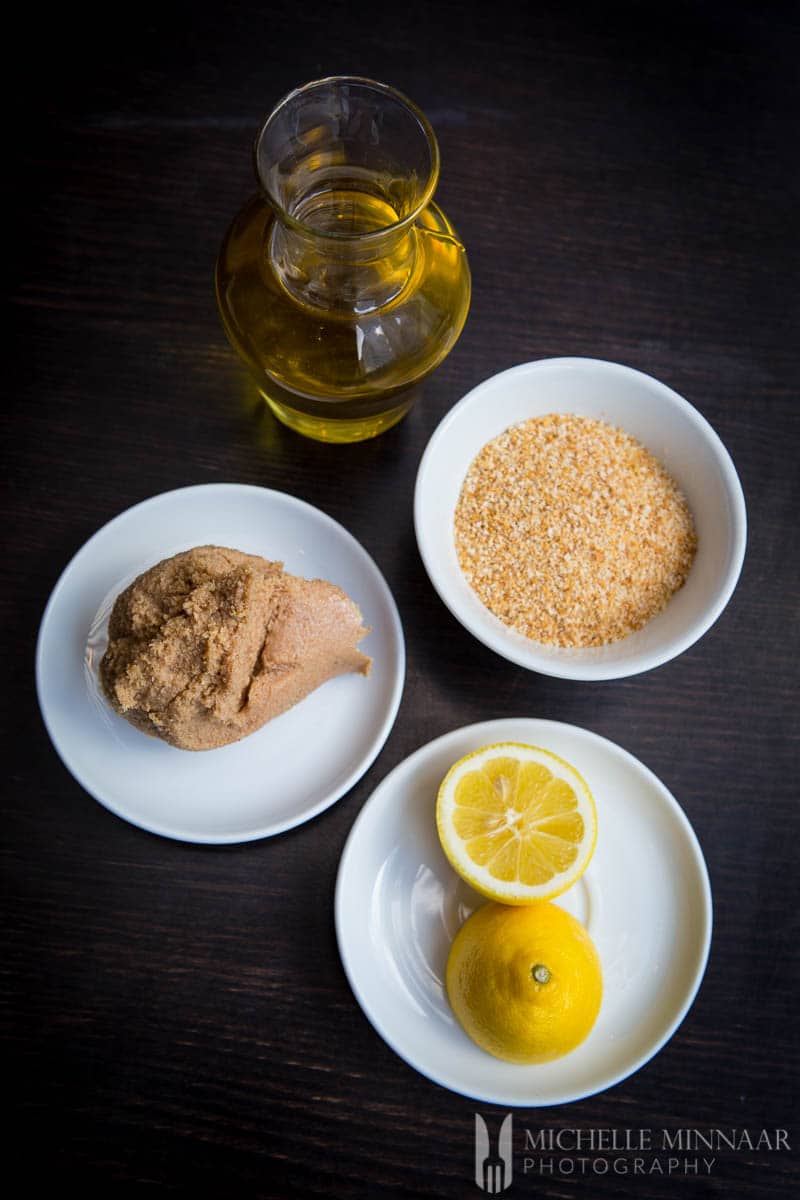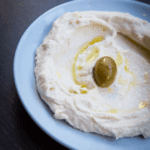This authentic Greek taramasalata recipe gives you the real deal, far from the store-bought versions filled with additives and fillers. Homemade is the way to go for a fresh, creamy dip. For more delicious ideas, check out my dip recipes.

Definition
Taramasalata, the famous Greek meze, is a mixture of names from three different cultures. The “tara” and “tarmac” from Turkish and Greek respectively, mean “fish roe”.
The Italian “insalata” makes up the rest of the word. So a direct translation would be “fish roe salad”. This is a very specific type of Greek meze based on fish roe.
If you haven’t tried it yet, it’s simply a must. For goodness’ sake, do not buy the ready-made stuff from the supermarket.
There are many variants of roe used in this mixture depending on the country or culture making it. Traditionally it is the smoked roe of carp, grey mullet or cod.
The latter is then mixed with different ingredients again depending on the culture of the person preparing the dish.
The staple ingredients are a starchy base of bread or a gluten free mix of potatoes with lemon juice and olive oil. Sometimes almonds are included as well.

Taramasalata is eaten as a dip or spread in meze platters, served with crudites and numerous savoury nibbles like crisps. It’s delicious as a spread on bread and toast.
Lent
Clean Monday is the first day of Great Lent. Different cultures associate Taramasalata with Lent celebrations and enjoy it with the unleavened sesame bread “lagana”.
Over time, as with all religious meals and dishes that are symbolic practices and rituals, it has, fortunately for us, become an everyday snack, without the required sacred practices that accompany it.

Store Bought Taramasalata
This may come as quite a shock to you, but proper Taramasalata should be creamy ivory in colour. It may be slightly brown depending on the curing process of the roe.
The commercially produced pink junk, readily available at shops, contains an enormous amount of food colouring and tastes nothing like the original meze from Greece.
Make a point of reading the label of your go-to fish dip. Ideally the roe content should form a minimum of 70% of the product's contents, not 70% bread crumbs or other fillers and 30% roe.

Artificial Food Colouring
If you live in Europe, count your blessings because your lawmakers passed legislation to force food manufacturers to either not use artificial colourants in foodstuff or to label the products with a warning of its contents.

Deathly Colourant
Artificial colourant is a ticking chemical time bomb that is life threatening. If you live in a country that does not have food regulations curbing the use of this deathly ingredient, you need to know what you and your children are consuming.
This completely unnatural chemical is added to our food to induce the impulse buying psychology in consumers. Artificial food colouring causes us to think the food is healthier due to its robust colour.
Consumer Psychology
The more yellow the butter, the healthier the grass fed organic cow was that the milk came from. Red, pink, orange, blue… All these colours and more lead us to think of crunchy organic red peppers or bursting ripe red strawberries or blueberries in that vitamin packed water we drink - are good for us.
Manufacturers rely on this adverse psychology that consumers have, our thought process is “if it has no colour it is not healthy”. When in fact, it is the other way round - the less or more natural the colour, the healthier it is for you.

Use Natural Colouring
Natural colouring has been used for civilisations and there are exceptionally healthy alternatives to adding zesty colour to your meals. If you really feel the need to add colour to your Taramasalata, below are a few ideas.
If you have fussy kids and worried about their Omega-3 oil intake, make some funky coloured dip instead of forcing cod liver oil down them!
Beetroot
Beetroot for red, available in powder or you can juice it yourself. Check the sugar content of a pre- manufactured powder as flavouring.
Carrots and Pumpkin
Carrots and pumpkin work like a bomb for orange. Little bits of saffron or turmeric for yellow. Saffron can be really expensive, so if you or anyone you know is travelling to the Middle East, ask them to bring you some.
Would you like to save this?
I was fortunate to have a friend bring a huge bottle back from Dubai for me at a fraction of the price we pay locally.
Green
Spinach or liquid chlorophyll works wonders for green grass cupcakes and “crème soda” drinks for the kid's parties.

Blue
Now blue interestingly enough comes from cooking up boiled red cabbage and baking soda!
Purple
Purple is just plain boiled red cabbage.
Cocoa Powder
For darker colours or chocolate add a little natural organic cocoa powder.
Please understand you will not get the neon or freaky striking colours from these natural products that chemical colourings have, but it’s healthier.

The Roe in Taramasalata
Roe is fish eggs. The name of the species will always precede the name as in cod roe. No, it’s not caviar. It's easy to get confused.
Caviar
Originally “caviar” was the name only given to wild sturgeon eggs from the Black and Caspian Sea. A further dilution of cultures and the adulteration of the word “caviar” now includes any eggs from all other species of sturgeon.
Beluga Caviar
The most expensive caviar “Beluga caviar” are the eggs of the Huso Huso (beluga sturgeon) only found in the Caspian Sea and the basin of the Black Sea.
It is pitch black, unlike the commonly available pink colour of the roe we use. At the turn of the century, Beluga Caviar market prices were in the range of 7 – 10 000 USD per kg.
Fortunately, we don’t use this roe in our recipe for the traditionally authentic and humble taramasalata.
Please Find Nemo
For those of us who have seen “Finding Nemo”, we all know fish spawn their eggs in their common habitats and wait for the gestation and hatching of their eggs. That’s if another big ugly fish doesn’t come and eat them first.
Fishermen don’t swim around underwater and look for these masses of pre-laid eggs. Nor do they quickly scoop up the eggs and chuck them in a tin to sell to us. They don't squeeze the fish underwater to pop her eggs out into a waiting basket either.
Migration
Roe is harvested from dead, pregnant fish before they spawn. Fisherman actually sit and wait on the water for older fish, about 10 years old, who are migrating and about to lay their eggs. They catch it before it can spawn and cut open its belly before removing the roe.
The un-spawned roe is located in a sac in the mother's belly, much like us humans that have an embryonic or amniotic sac where our babies grow.

Embryonic Sac For Sale
You can actually find fishmongers or butchers who may even have this entire untouched sac for sale, already cured and vacuum packed. At home you can cut the sac and inside, tightly packed together are millions of little fish eggs, a monumental supply of roe.
Don’t tell your kids.
Tubs and Tins
That seems a bit extreme to me. I will just stick to the usual little tubs from the delicatessen down the road or you can purchase here on Amazon. Once you have purchased your roe you can make the most divine, naturally simple and authentic taramasalata.
Love Greek food? Then check out my Grilled Halloumi, htipiti, tzatziki, white bean dip and melitzanosalata!
Print📖 Recipe

Taramasalata
- Total Time: 30 minutes
- Yield: 8 servings 1x
- Diet: Low Lactose
Ingredients
- ⅔ cup breadcrumbs
- 5 tablespoons lemon juice
- 1 cup water
- ½ cup cod roe paste
- 2 ½ cups vegetable oil
Instructions
- Mix the breadcrumbs with the water and lemon juice in a bowl. Let the mixture soak for at least 15 minutes to fully hydrate.
- After soaking, drain off any excess liquid and transfer the breadcrumbs to a food processor. Add the cod roe paste.
- Blend on the highest setting until the mixture is completely smooth.
- With the food processor running, slowly drizzle in the vegetable oil. Add it gradually to prevent the mixture from splitting. If too much oil is added at once, the texture may break.
- Once smooth and creamy, serve the taramasalata immediately or store it in an airtight container in the fridge for later.
Notes
- This recipe yields 800g (2lb).
- Its shelf life is 3 days.
- The quality of roe paste used is crucial to the success of the recipe.
- Different parts of Greece have different versions of taramasalata. Some are stronger in flavour, while others' have more texture.
- Be patient when adding the oil. You need to add it slowly, otherwise the mixture will split.
- Ensure that the breadcrumbs have properly soaked before proceeding with the recipe.
- If you have added all the oil but find the taste too dense, you can add little amounts of water at a time to lighten the strength of the dip.
- Prep Time: 30 minutes
- Cook Time: 0 minutes
- Category: Starter
- Method: Blitz
- Cuisine: Greek
Nutrition
- Serving Size: 1 serving
- Calories: 541
- Sodium: 2 mg
- Fat: 58.8 g
- Saturated Fat: 8.4 g
- Carbohydrates: 5.4 g
- Protein: 3.3 g
save the recipe to your pinterest board






CC Hogan
The best Taramasalata I ever had was from Efes restaurant in Great Titchfield Street, London. It was often thought as one of the best Turkish restaurants in London beloved of many a BBC Celeb. There were signed photos all over the wall. I lived opposite. Kazim (the turkish owner), mad a taramasalata that was so thick you could almost carve it. But it was as creamy as anything. He made it from Tarama (cured but not smoked roe), and yes, like many Turks, he used food colouring to make it bright pink. We are all still breathing!
But I have never managed to replicate his Taramasalata.
Kavey
Homemade taramasalata is so much nicer than shopbought, especially in appearance - hate the lurid pink version! This looks great!
Camilla Hawkins
This brings back memories of when I worked in catering and we made taramasalata, I remember the large orange sack of roe vaguely. I think we must have sold it in the shop that was out at the front along with all the salads, soups, quiches, cakes and fine chocolates. It was then like Nigel Slater I realised that catering was not a job I had the stamina for! Lovely recipes and shots as always:-)
Ren Behan
Well I definitely feel like I've learned a lot from reading your post, who knew! It's always worth making your own food from scratch, especially when the shop bought stuff is full of such nasties.
Jo of Jo's Kitchen
Wow! I didn't know shop brought Taramasalata was so complicated. Definitely homemade for me from now on!
Gingey Bites
Wow, this has been an educational read! I did not know that about fish roe mainly coming from older fish which've died naturally, I think that's great!
Thanks for sharing this recipe, I'll never buy the pink goop again!